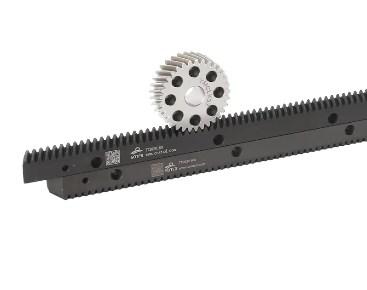How Surface Treatments Improve Wear and Corrosion Resistance of Precision Gear Rack

Introduction
When engineers evaluate the long-term reliability of a Precision Gear Rack, questions often arise about whether surface coatings can enhance its resistance to wear and corrosion. Since these components are widely used in heavy-duty applications, exposure to friction, moisture, and corrosive elements can significantly affect performance and lifespan. Surface engineering offers potential solutions, but its effectiveness depends on both the coating material and the application environment.
Wear Resistance Through Surface Treatments
One of the primary advantages of applying coatings to gear racks is the improvement in wear resistance. Hard coatings such as chromium plating, nitriding layers, or diamond-like carbon can increase surface hardness, reducing the rate of tooth wear during prolonged operation. By minimizing direct metal-to-metal abrasion, coatings help preserve the rack’s geometry, ensuring consistent engagement with the mating gear. This not only prolongs service life but also maintains transmission accuracy over time.
Corrosion Protection Mechanisms
Beyond wear resistance, coatings also play a key role in preventing rust and chemical degradation. In environments with high humidity, salt exposure, or industrial contaminants, unprotected steel surfaces are prone to oxidation and pitting. Coatings such as zinc plating, nickel plating, or specialized polymer films form a protective barrier that isolates the rack from corrosive agents. This barrier delays the onset of rust, reducing maintenance frequency and ensuring reliable operation in outdoor or marine conditions.
Considerations and Limitations
Although surface coatings bring clear benefits, they are not without limitations. Improperly applied coatings may crack under heavy load or peel away due to repeated stress cycles. In addition, coating thickness must be carefully controlled, as excessive build-up can alter tooth geometry and compromise meshing accuracy. Engineers must balance the benefits of added protection with the need to preserve dimensional precision, which is the defining feature of a high-performance gear rack.
Application-Specific Selection
The choice of coating should always be based on the intended application. For high-friction, high-load systems, hardening treatments such as nitriding are often more suitable. For corrosion-prone environments, zinc or nickel coatings provide more reliable protection. In some cases, hybrid approaches—such as combining heat treatment with a corrosion-resistant coating—offer the best balance between durability and performance. Careful material and process selection ensure that the rack can withstand both mechanical and environmental challenges.
Surface coatings can indeed enhance both wear resistance and corrosion protection for gear racks, provided they are selected and applied appropriately. By combining advanced coating technologies with precise manufacturing and proper maintenance, engineers can extend service life, reduce downtime, and improve reliability. While coatings are not a universal solution, they are a valuable tool in tailoring gear rack performance to meet demanding operational environments.
Precision Gear Rack
Technical requirement
Quality Grade: DIN 6
Material: S45C/ 42CrMo
Tooth type: straight tooth.
Production process: four sides grinding, tooth surface grinding, and V rail surface grinding.
Hardness treatment: high frequency quenching HRC48-52°/ carburizing quenching HRC55-60°
- Art
- Causes
- Crafts
- Dance
- Drinks
- Film
- Fitness
- Food
- Giochi
- Gardening
- Health
- Home
- Literature
- Music
- Networking
- Altre informazioni
- Party
- Religion
- Shopping
- Sports
- Theater
- Wellness


